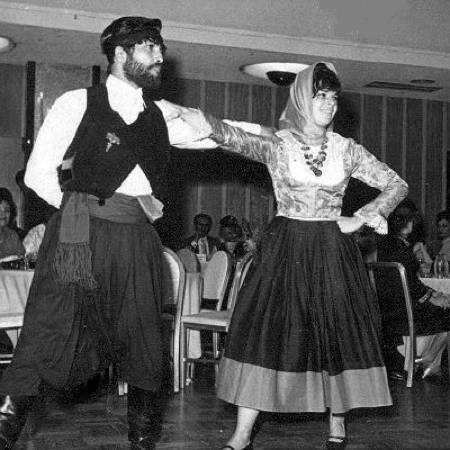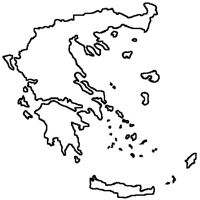
|
The Society of Folk Dance Historians (SFDH)
Greek Traditions in Music and Dance
[
Home |
About |
Encyclopedia | CLICK AN IMAGE TO ENLARGE |

|

 The tradition of music in Greece goes back thousands of years. It is part of a national heritage treasured by the Greek people like a precious heirloom from ancient Greece, since this divine gift was entrusted to them by Apollo and the patron Muse, Terpsichore, presided over their dances.
The tradition of music in Greece goes back thousands of years. It is part of a national heritage treasured by the Greek people like a precious heirloom from ancient Greece, since this divine gift was entrusted to them by Apollo and the patron Muse, Terpsichore, presided over their dances.
To this very day, music is an inseparable part of Greek life. In his dances and songs, the Greek gives vent to his dramatic expression to glorify his joys, to wallow in his sorrows, and above all, to record his inspirations, the history, and the lore of his people, and to store up legends and folktales.
Greek folk music is a superb combination of elements of ancient Greek music, a theoretical basis of scales and rhythm forms, some oriental influence, perhaps as a result of the expeditions of Alexander the Great, fused together under some mannered conditions from Byzantine life and the post-Byzantium ages. It is definitely, with very few exceptions, entirely free of any of the characteristics found in Western music.
This exception can be traced particularly to the Ionian Islands between Italy and Greece, and mostly due to the influence of the Venetian reign, which successively assimilated into the lifestream of European thought and art. The Ionian Islands remained under Venetian rule and influence until very late in the 19th Century.
The folk dances of Greece are accompanied by music played on traditional instruments and sometimes also with a song. The dances, for the most part, fall into two classifications: the very lively Pidiktos and the more restrained Syrtos. The Pidiktos is a jumping and leaping dance, the Syrtos, a smooth flowing, dragging dance. Another category is the mixed dances where they alternate from Syrtos to Pidiktos and back again. The most common trait, however, is that they begin slow and quaint and then build to the leaping and jumping dances.
The Pidiktos, or leaping dances, are indicative of the rugged mountains of Greece. There, the life is bolder and thus the very strain of mountain life is depicted in movements, especially in the virile and stark movements of the men. The raising of the leg and the leaps in the air almost seem to rise to the need of man to challenge culture. There are expressions of a dancer, either during a dance or in describing him afterwards, as to how he leaped over the mountains in his dancing.
The Syrto, or 'dragging' dances, are usually seen in the lowlands, on the coastal regions, and of course, on islands. These dances tend to characterize the more peaceful landscape and lyrical moods of the seashores and the tender, easy going Agean Sea.
In areas where there are dramatic changes in the landscape, and almost both qualities of the valley and the mountains are mixed, we see a peculiar mixture of both these qualities described in movement. Most Pidiktos dances are danced specifically by men, whereas the Syrtos dances are performed by both men and women.
Used with permission of the author.
This page © 2018 by Ron Houston.
Please do not copy any part of this page without including this copyright notice.
Please do not copy small portions out of context.
Please do not copy large portions without permission from Ron Houston.